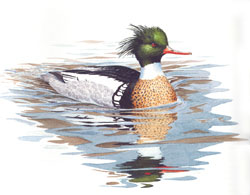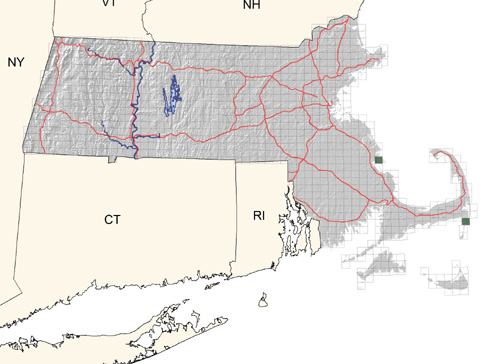Breeding Bird Atlases (BBA)
Find a Bird - BBA1
Breeding Bird Atlas 1 Species Accounts
Red-breasted Merganser
Mergus serrator
Egg Dates
June to July
Number of Broods
one

Although the Red-breasted Merganser has been alleged to breed in Massachusetts since 1877, apparently its nest never has been found, and breeding evidence has always been based on the discovery of broods of flightless young or the suggestive behavior of summering adults. Despite its rarity as a state breeding bird, this merganser is recorded consistently in the historical accounts as nesting locally along the southern coast of Massachusetts, primarily at Monomoy Island and on Cape Cod along Nantucket Sound. There is a single breeding record for Essex County in 1916. The Atlas produced two confirmations: one from Duxbury in Plymouth County and one from Monomoy National Wildlife Refuge. Otherwise, the species is abundant as a coastal spring and fall migrant as well as a winter resident. A few nonbreeding individuals can generally be seen during the summer at scattered coastal localities.
By March and April, large numbers of northbound migrants join the wintering birds and gather in spectacular staging aggregations in eastern Cape Cod Bay. Decidedly birds of open ocean or saltwater bays, “Salt-water Sheldrakes” seldom venture far inland, where they occur only as casual migrants on large lakes and reservoirs. In this season, small parties of mixed sexes congregate on quiet waters, where the drakes display with much neck stretching, bobbing, splashing, and calling. Pair bonds are often established before the birds depart from Massachusetts waters. The species apparently breeds in June. Nests are placed on the ground, usually close to either a freshwater pond or salt water. The eight to ten unmarked, olive-colored eggs are deposited in a hollow that is lined with down, feathers, and occasionally dry plant material. The nest is well concealed, frequently being located beneath overhanging vegetation.
The drake abandons the hen early in the breeding cycle, leaving her to incubate for the 29 to 35 days required for the precocial young to hatch. In Massachusetts, it appears that the young are taken directly to salt water because all breeding evidence has been based upon broods of small, flightless young on the ocean. Both of the Atlas records are from 1978. A female with a brood of young was observed at Duxbury Beach. A downy young was observed crossing the flats on Monomoy Island at the end of July (Trull), and what was probably the same youngster was seen again on August 5. Juveniles are reported to be capable of flight in 59 days.
By late September, and increasingly through October and November, migrating Red-breasted Mergansers are a familiar sight from coastal vantage points. In this season, most are “brown-heads” because the immatures and eclipse-plumaged drakes resemble the females. By late fall, the mature drakes are recognizable as such. The birds often move in especially large numbers on days of easterly winds in conjunction with various species of sea ducks. In some years, tremendous gatherings of mergansers occur in November and December at various Cape Cod locations and in the vicinity of Nantucket and Martha’s Vineyard. Wintering concentrations gradually disperse, and, from December on, the population is more or less stable until the spring flight is again initiated.
Map Legend and Data Summary
Atlas 1 data collected from 1975-1979


Note: rare, local, and probably irregular along south-eastern coast
Wayne R. Petersen



